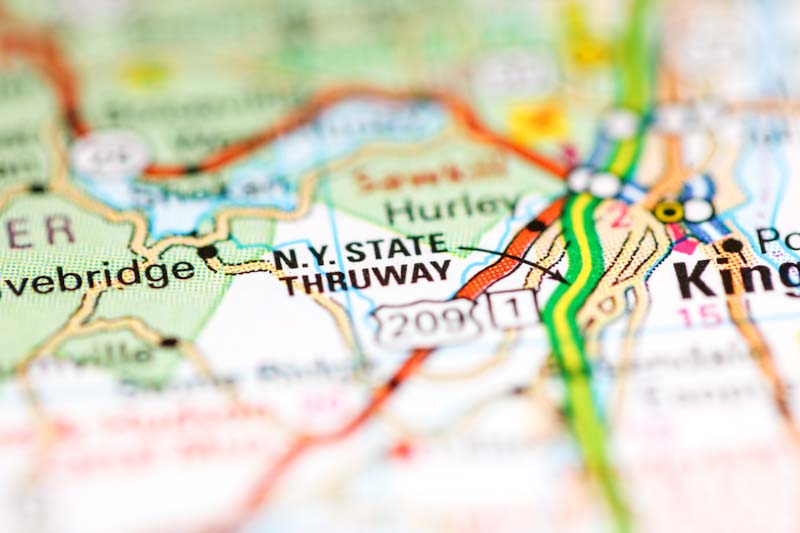Thruway Seeks New Tolls To Fund Operations, Capital Plan Thru 2027
Public Comments May 16
By GEORGE DRAPEAU – May 19, 2023
WEST NYACK, NY—Local motorists, truckers and residents voiced their opinions here at the Palisades Center on May 16 over the New York State Thruway Authority’s proposal to increase revenues to help finance its ambitious and needed $1.9-billion 2023-2027 capital plan.
To support the improvements, the Thruway Authority is seeking to raise tolls about 5 percent for 2024 and another 5% in 2027. Officials said it would be the first systemwide increase in 14 years, and the toll adjustments are necessitated by an additional nearly $500 million in needed infrastructure work that is currently not supported by the funding stream of the existing 2022-2026 capital plan.

Meanwhile, tolls systemwide are expected to remain the same throughout 2023.
Another contributing factor for the need for toll adjustments was the $125 million in decreased revenue collected by the Thruway Authority since the height of the pandemic in 2020. Those funds would have gone directly into the capital program, the Authority reported, while the revenue decline related to COVID accounted for 17% of revenues collected by the Thruway Authority and was seven-times greater than anything the Thruway experienced in the last 40 years, a Thruway official noted, adding that the Authority is still recovering from that lost ground. The current projection is that revenues will be $240 million lower than what the authority had forecasted prior to COVID 2020 through 2025 period, according to reports.
Several representatives of the business community and construction industry also gave brief presentations. “No one likes to pay higher tolls nor do New York State officials like to increase tolls, but the simple fact is that tolls have not increased system-wide since 2010,” said John T. Cooney, Jr., executive director of the Construction Industry Council of Westchester & Hudson Valley Inc. “Furthermore, the cost per mile after the proposed increase will still be amongst the lowest in the Northeast,” he said, pointing to the turnpike systems in the neighboring states of New Jersey, Pennsylvania, Ohio and Massachusetts.
It was noted that the Thruway Authority was not eligible for any COVID-related funding assistance. The Thruway is a user-fee supported roadway and receives no federal, state, or local tax dollars.
While speaking at the public hearing in Rockland, Mr. Cooney referenced a recent report published by the national transportation research group, TRIP, which raised concerns over the repeated resurfacing of the Thruway in that it is not addressing the continuing deterioration of the roadway’s subbase. This, he opined, is undermining the capital plan.
“In the report, TRIP sighted a 2019 Transportation Research Board report in which it was noted the repeated resurfacing of the Thruway was not addressing the continuing deterioration of roadway subbases and was resulting in diminishing returns. The report goes on to recommend a full-depth pavement reconstruction. The TRIP Report points out that based on current funding levels the Thruway’s average pavement conditions are anticipated to decline by 31 % from a rating of 64 to 44 which is poor condition.”
In 2021, Thruway Authority staff conducted a five-year “Needs Assessment” that identified an additional $470 million in capital project needs that are currently not supported by the resources available for the existing 2022-2026 Capital Program. The shortfall is based on the fact that 85% of the Thruway’s roadway base dates back to its original construction, highlighting the need for heavy maintenance, reconstruction, and rehabilitation activities to keep the riding surface of the 570-mile superhighway in a state of good repair.
The average age of the Thruway’s 815 bridges is 55 years old, with 75% of those bridges more than 60 years old. More than 85 of those bridges have been identified for replacement within the next decade. Thruway officials noted that the need to replace bridges grows exponentially after the 10-year timeline when hundreds of bridges will need to be replaced in the following decade. Also, there are 120 interchanges with only 15% of the original construction having been rebuilt or replaced
They added that the projected replacement cost for the most immediate 85 bridges needing replacement is roughly more than $800 million in today’s dollars, not accounting for recent inflation. Factoring the hundreds of bridges that will require replacement not long, thereafter, the costs escalate into the $6 billion to $7 billion range, which the existing toll rate structure will not support.
